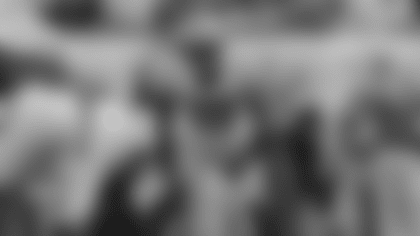Tim Harris
- Inducted: 2022
- Linebacker: 1986-90
- Height: 6-6; Weight: 260
- College: Memphis State, 1982-85
Honors:
- Associated Press All-Pro Team (chosen since 1940): 1989
- Other years selected to an all-pro first team: 1988
- Pro Bowl Selection (played from 1950-2021): 1989
For more than 30 years, from the time the 4-3 defense came into vogue in the 1950s into the 1980s, the Packers were blessed with several outstanding outside linebackers who could cover a lot of ground. Among them were Dave Robinson, Lee Roy Caffey, Fred Carr, Ted Hendricks for a season, John Anderson and Mike Douglass.
But their job was basically to resist and retreat. Take on blockers at the line and then either chase the ball or backpedal into coverage. But with the advent of the 3-4 defense in the 1970s followed by Lawrence Taylor's arrival into the NFL in 1981, the role of outside linebackers changed.
Attack mode became the modus operandi. And Tim Harris, in turn, became the first Packers' outside linebacker charged with playing full speed ahead. Rushing the passer was his special calling.
Drafted in the fourth round in 1986 after playing as a down defensive end at what was then Memphis State, Harris got off to a slow start in his first training camp when the Packers tried to mold him into a traditional outside 'backer in a 3-4 scheme. It wasn't until coach Forrest Gregg ordered Harris to join the defensive linemen for pass rush drills one day and warned him if he didn't cut it there, he'd ship him back to Memphis "where he could play with Elvis Presley," that his career took off.
Seven games into his rookie season, Harris finally cracked the starting lineup and wound up leading the Packers with eight sacks. Five years later, after playing his last game with the Packers, Harris was recognized as their career sack leader with 55, although it had been only seven years since sacks were first recorded as an official statistic. He also was credited with the club record for sacks in a season with 19½ in 1989.
Based on the defensive coaches' film reviews, Ezra Johnson had bettered both numbers, albeit unofficially, with 85 career sacks and 20½ sacks in 1978. But his numbers from 1977-81 didn't count.
Take nothing away from Harris, however. He led the Packers in sacks in each of his five seasons with them and could be remarkably dominating at times. Two examples would be the Packers' 34-14 victory over Minnesota in 1988, when Harris had five solo tackles, two sacks, a safety and a blocked punt. A year later in a 23-21 victory over Atlanta, he had four sacks.
In fact, Harris became such a dominant force that when Sport magazine polled three NFL personnel executives – Dick Steinberg of New England, John Butler of Buffalo and Bob Hollway of the Vikings – along with defensive-minded head coach Jerry Glanville of the Houston Oilers and asked them in 1989 to rank the best linebackers in the game, Harris topped the list. The legendary Taylor, then in the ninth of his 13 Pro Football Hall of Fame seasons, finished second.
"Awesome is the closest word," said Hollway when asked to describe Harris. "He has a great under move on the blitz and simply overpowers anybody in his way. You have to block him with a tackle. He'll kill a back." Future Pro Football Hall of Fame tackle Jimbo Covert of the Bears also was interviewed for the story. "Harris is as good a defensive player as there is in the NFL," said Covert. "He's big. He can run. And when you watch a guy who has fun playing football, it's him."
At close to 6-6, Harris embarked on his Packers' career at a lean 235 pounds. In his best years, he played between 250 and 260. At the end, his weight reached nearly 280. But what he basically retained throughout his time in Green Bay was his deceptive speed and strength. He had what linebackers coach Dick Moseley called "elastic legs" to beat blockers off the line and out quick them on the rush, along with long arms and strong hands that allowed him to overpower offensive tackles who outweighed him by 25 pounds or more.
"It's pretty amazing that he can be so big and yet make himself so thin when he slices between blockers," said Moseley, Harris' linebackers coach from 1988-90. "Or he can bull over a 300-pounder as if he's a cow on roller skates."
Perhaps most importantly, Harris' effort was relentless, not to mention contagious, earning him the ultimate compliment from opposing coaches. Week after week he became the focus of their game plans.
"When you play Green Bay, you're aware of Tim Harris," Bill Kuharich, director of player personnel for New Orleans, said in 1989. "Just like when you play the Giants, you're aware of Lawrence Taylor and Carl Banks, and when you play the Vikings you're aware of Chris Doleman."
Back when the NFL frowned on any form of post-play celebration, Harris drew attention to himself perhaps like no other defender in the league by standing over sacked quarterbacks and firing two imaginary six-shooters. That was on top of his constant trash-talking to opposing players.
Those outbursts did a slow burn, especially on the Packers' two most bitter rivals, the Bears and Vikings. "Sometimes God blesses people with talent and takes away their brains," Chicago coach Mike Ditka once fumed. But there were also players on those teams who conceded that Harris could also walk the walk. Vikings longtime center Kirk Lowdermilk ripped Harris for his showboating but also admitted he voted for him for the 1989 Pro Bowl. "Yeah, I voted for him," Lowdermilk said grudgingly. "You know a guy performs like that. But when he beats you, he just rubs it in your face. But that is his game. That's the way he plays."
In late September 1991, following a Packers' record 78-day holdout covering five regular-season games, Harris was traded to San Francisco for two second-round draft choices, one of which the 49ers regained over a complaint that the Packers hadn't revealed a drug investigation involving Harris during the trade talks, which they were then able to tie to the team's hiring of Mike Holmgren as coach.
Harris played two seasons with the 49ers and registered 17 sacks in 1992. Concerned over his off-the-field issues, which stemmed to his years in Green Bay, the 49ers let him escape to Philadelphia as a free agent in 1993. The Eagles needed a pass rusher to replace Reggie White, who had signed with the Packers as a free agent.
As it turned out, Harris appeared in only four games for the Eagles due to an elbow injury and was released in July 1994. Then with five games left that year, the 49ers re-signed Harris, and he recorded 4½ sacks in their three playoff games en route to winning Super Bowl XXIX. Harris' final season was 1995. In all, he played 10 years, five in Green Bay, where he appeared in 76 games and started 70.
Born Sept. 10, 1964. Given name Timothy David Harris.














